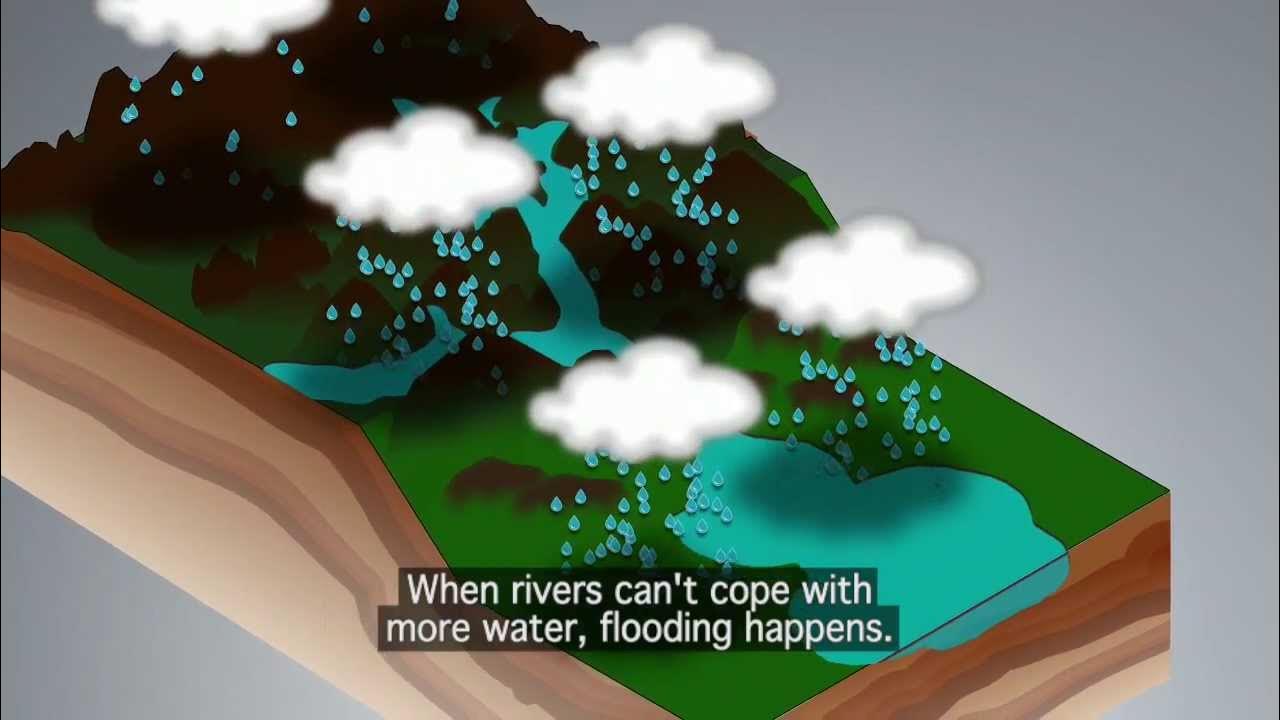Flood Management: Soft & Hard Engineering | AQA GCSE 9-1 Geography
Summary
TLDRThis script delves into flood management strategies, distinguishing between hard engineering, such as embankments, dams, river straightening, and flood relief channels, and soft engineering, which includes afforestation, flood warnings, land use zoning, and wetland storage. Hard engineering, while effective, can be costly and damaging to the environment, whereas soft engineering complements natural processes to mitigate flood risks sustainably and economically.
Takeaways
- 🏗️ Hard engineering techniques include the construction of artificial structures like embankments and dams to control river processes and prevent flooding.
- 🌳 Soft engineering techniques involve working with natural processes, such as afforestation, to mitigate flood risks by increasing interception and infiltration rates.
- 🚨 Flood warnings are a crucial part of flood management, providing different levels of alerts to help people prepare for and respond to flood events.
- 💧 Dams can serve multiple purposes like water supply, electricity generation, and recreation, but they also have downsides such as high costs and habitat destruction.
- 🌊 River straightening can reduce flood risks in the immediate area by creating deeper and straighter channels, but it may increase risks downstream due to faster water flow and erosion.
- 🛤️ Flood relief channels are artificial waterways built alongside rivers to carry excess water away from valuable areas during high river flow, reducing local flood risks.
- 🛡️ Embankments can be made from materials like concrete or riverbed mud, offering a more natural appearance and lower cost, but they pose a risk of catastrophic failure.
- 🏞️ Land use zoning restricts development in flood-prone areas, leaving some areas empty and using others for less critical purposes to minimize economic losses during floods.
- 🌊 Wetland or flood storage areas are parts of the floodplain intentionally allowed to flood, reducing downstream risks at the cost of lost land use.
- 🚨 The Environment Agency in England uses a three-tiered flood warning system to communicate the severity of expected flood events to the public.
- 🌐 The script highlights the balance between hard and soft engineering approaches to flood management, emphasizing their respective advantages and disadvantages.
Q & A
What are the two main categories of flood management techniques mentioned in the script?
-The two main categories of flood management techniques are hard engineering and soft engineering.
What is the purpose of embankments in flood management?
-Embankments are raised river banks designed to hold more water and reduce the risk of flooding. They can be made of concrete or mud dredged from the riverbed.
What was the consequence of the failure of flood walls during Hurricane Katrina in 2005?
-The failure of flood walls during Hurricane Katrina in 2005 resulted in 80 percent of New Orleans being flooded.
What are the additional purposes of dams besides flood control?
-Dams serve additional purposes such as providing water supply, generating electricity, and recreation.
What are some of the controversies associated with the use of dams for flood management?
-Dams can be controversial due to their high cost, the destruction of habitats and homes when creating the reservoir, and the sediment buildup that reduces the reservoir's capacity over time.
What is river straightening and how does it help in flood management?
-River straightening involves cutting a straight channel through meanders, making the river deeper and faster-flowing, which can reduce the flood risk in the straightened area but may increase the risk downstream.
What is the role of flood relief channels in flood management?
-Flood relief channels are artificial river channels built alongside rivers to carry excess water away from valuable areas during high river flow, thereby reducing the risk of flooding.
What are soft engineering techniques in flood management?
-Soft engineering techniques involve working with natural processes to reduce the risk of flooding, such as afforestation and flood warnings.
How do trees contribute to flood management through afforestation?
-Trees increase the rates of interception and infiltration, slowing the time it takes for a river to reach peak discharge, and provide additional environmental benefits.
What are the different levels of flood warnings issued by the Environment Agency in England?
-The Environment Agency in England issues three levels of flood warnings: flood alert, flood warning, and severe flood warning, indicating increasing levels of risk to human life and property.
What is land use zoning in the context of flood management, and how does it help reduce flood risks?
-Land use zoning involves restricting what can be built in floodplain areas, leaving the area next to the river empty and using adjacent areas for less valuable purposes, thus reducing the risk of high-value land being flooded and lowering economic losses.
What is the concept of wetland or flood storage areas in flood management?
-Wetland or flood storage areas are parts of the floodplain that are deliberately allowed to flood, storing excess water to effectively reduce the risk of flooding downstream, although this means the land can no longer be used for other purposes.
Outlines

This section is available to paid users only. Please upgrade to access this part.
Upgrade NowMindmap

This section is available to paid users only. Please upgrade to access this part.
Upgrade NowKeywords

This section is available to paid users only. Please upgrade to access this part.
Upgrade NowHighlights

This section is available to paid users only. Please upgrade to access this part.
Upgrade NowTranscripts

This section is available to paid users only. Please upgrade to access this part.
Upgrade NowBrowse More Related Video

Mississippi case study

Flooding: Why it happens and how we can help

BEGINILAH CARA BELANDA MENGURAS AIR LAUT DAN TINGGAL DI BAWAH PERMUKAAN LAUT!

Why The Netherlands Isn't Flooding (Anymore)

Upaya Gagasan Geobag untuk Menanggulangi Banjir Dianggap Tidak Tepat Oleh Gubernur Kalimantan Barat

Why Engineers Can't Control Rivers
5.0 / 5 (0 votes)